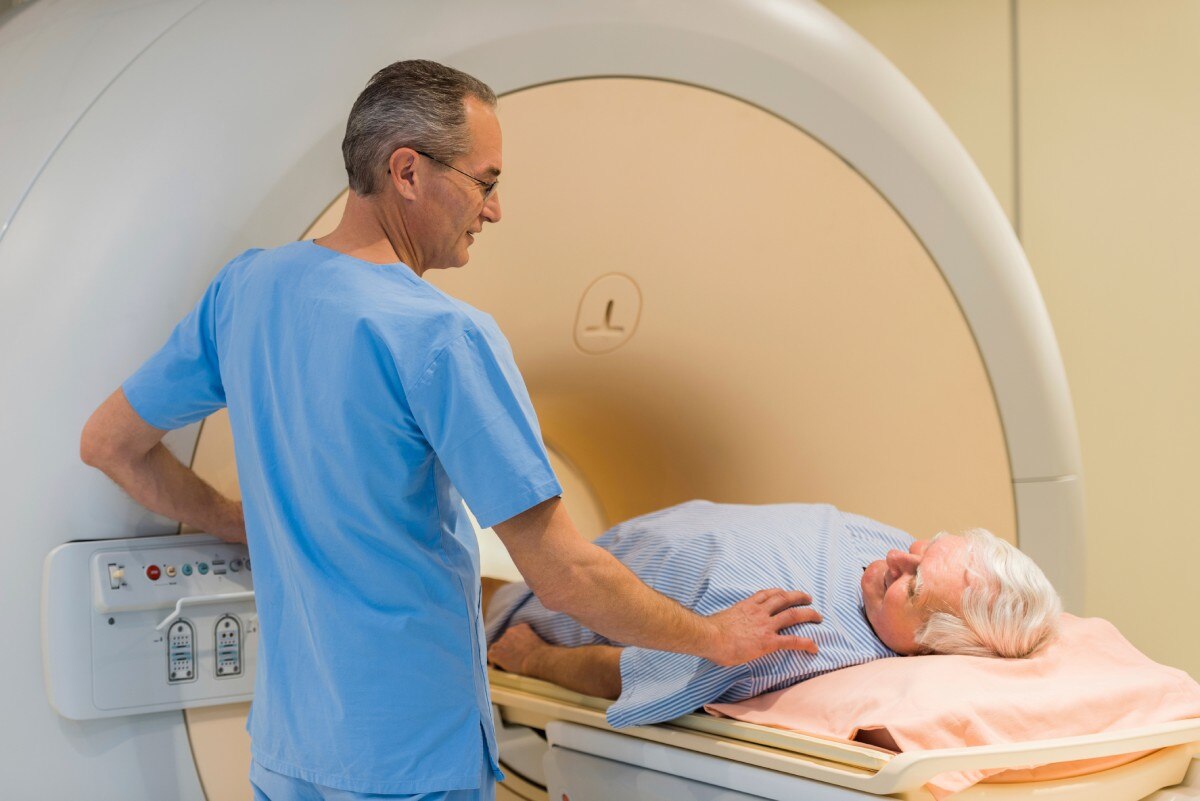Virtual Colonoscopy
On this page:
- What is virtual colonoscopy?
- Why do doctors use virtual colonoscopy?
- How do I prepare for a virtual colonoscopy?
- How do health care professionals perform a virtual colonoscopy?
- What should I expect after a virtual colonoscopy?
- What are the risks of a virtual colonoscopy?
What is virtual colonoscopy?
Virtual colonoscopy is a procedure in which a radiologist uses images created by x-rays and a computer to examine your rectum and colon from outside the body. The rectum and colon make up most of your large intestine.
Virtual colonoscopy can show ulcers, polyps, and cancer.
Does virtual colonoscopy have another name?
Virtual colonoscopy is also called computed tomography (CT) colonography.
How is virtual colonoscopy different from colonoscopy?
Virtual colonoscopy and colonoscopy are different in several ways.
Virtual colonoscopy uses x-rays to capture images of the inside of your body. In colonoscopy, a doctor inserts a flexible tube with a camera on one end, called a colonoscope, to look inside your rectum and colon.
Unlike colonoscopy, you won’t need sedatives or anesthesia for a virtual colonoscopy. Virtual colonoscopy also takes less time than a colonoscopy.
Research suggests that virtual colonoscopy may not be as effective as colonoscopy at finding certain polyps.1 Also, doctors can’t remove polyps or treat other problems during virtual colonoscopy, as they can during colonoscopy. Depending on the results of your virtual colonoscopy, your doctor may suggest a follow-up colonoscopy before making a diagnosis.
Your health insurance coverage for virtual colonoscopy and colonoscopy also may be different.
Why do doctors use virtual colonoscopy?
Doctors mainly use virtual colonoscopy to screen for colon polyps and colon and rectal cancer—also called colorectal cancer. Screening is testing for diseases when you have no symptoms. Screening may find diseases at an early stage, when a doctor has a better chance of curing the disease.
Screening for colorectal cancer
Your doctor will recommend screening for colorectal cancer at age 45 if you don’t have health problems or risk factors that make you more likely to develop colon cancer.2
You may be more likely to develop colorectal cancer if you2,3
- are age 45 or older
- are Black
- have a personal or family history of colorectal cancer
- have a personal history of ovarian cancer, polyps, or inflammatory bowel disease, such as ulcerative colitis and Crohn’s disease
- have Lynch syndrome or another genetic disorder that increases the risk of colorectal cancer
- have obesity, smoke cigarettes, or drink alcohol
If you are more likely to develop colorectal cancer, your doctor may recommend you get screenings at a younger age and more often.
Virtual colonoscopy is one test used to screen for colorectal cancer. Other screening tests may include
- colonoscopy, a procedure in which a doctor uses a flexible tube with a camera on one end to look inside your rectum and colon.
- flexible sigmoidoscopy, a procedure in which a doctor uses a flexible tube with a camera on one end to look inside your rectum and lower colon, including the sigmoid colon and descending colon. Doctors rarely use flexible sigmoidoscopy to screen for colorectal cancer.
- stool tests that check your stool for blood or changes in your DNA that may be related to colorectal cancer.
Talk with your doctor to see what screening options are right for you.
If you are older than age 75, talk with your doctor about whether you should be screened for colorectal cancer. For more information, read the current colorectal cancer screening recommendations from the U.S. Preventive Services Task Force (USPSTF).
Government health insurance plans, such as Medicare, and private insurance plans sometimes change whether and how often they pay for cancer screening tests. Check with your insurance plan to find out whether your insurance will cover a virtual colonoscopy to screen for colorectal cancer. If you don’t have insurance or your insurance won’t cover the procedure, call your local health department for help finding colorectal cancer screening tests.
How do I prepare for a virtual colonoscopy?
To prepare for a virtual colonoscopy, you will need to talk with your doctor, follow a special diet, clean out your bowel, and drink a special liquid called contrast medium.
Talk with your doctor
Talk with your doctor about any health problems you have and all medicines, vitamins, and supplements you take. Tell your doctor if you have an implanted medical device, as x-rays may interfere with some personal medical devices.
Doctors don’t recommend virtual colonoscopy during pregnancy. Tell your doctor if you are, or may be, pregnant. Your doctor may suggest a different procedure, such as a colonoscopy.
 Talk with your doctor before your virtual colonoscopy.
Talk with your doctor before your virtual colonoscopy.Follow a special diet
A health care professional will give you written bowel prep instructions to follow at home before the procedure, so that little or no stool remains in your large intestine. A complete bowel prep lets you pass stool that is clear and liquid. Stool inside your large intestine can prevent the x-ray machine from taking clear images of the lining.
You may need to avoid foods that have a lot of fiber—such as whole grains, raw vegetables, beans, and nuts and seeds—several days before the procedure.
You may need to follow a clear-liquid diet a day or more before the procedure. The written instructions you receive will tell you when to start and stop the clear-liquid diet.
Clear liquids do not contain pulp, solids, or cream. Your doctor may also recommend avoiding red- and purple-colored drinks or gelatin. In most cases, you may drink or eat
- fat-free bouillon or broth
- gelatin in flavors such as lemon, lime, or orange
- plain coffee or tea, without cream or milk
- sports drinks in flavors such as lemon, lime, or orange
- fruit juice with no pulp, such as apple or white grape—avoid orange juice, pineapple juice, and other cloudy juices
- water
Clean out your bowel
Different bowel preps contain different combinations of pill, liquid, or powder laxatives. Your doctor will help you find the best bowel prep for you. Some people will drink a large amount of liquid laxative over a scheduled period of time—most often, the night before and the morning of the procedure. Your doctor may also prescribe an enema.
The bowel prep will cause diarrhea, so you should stay close to a bathroom. This part of the bowel prep can be challenging, but it’s important to finish the prep completely. Call a health care professional if you have side effects that keep you from finishing the prep.
Drink contrast medium
Before the procedure, you will receive instructions for drinking a contrast medium. The contrast medium makes your rectum and colon easier to see in the x-rays. The contrast medium can also help your doctor tell the difference between stool and polyps.
Tell your doctor if you know you are allergic to contrast medium. Your doctor may give you medicines to lower your chances of having a reaction.
How do health care professionals perform a virtual colonoscopy?
An x-ray technician or other specially trained health care professional performs a virtual colonoscopy at an outpatient center or a hospital. The procedure usually lasts about 15 minutes.4
During the procedure, you will typically lie on a table while the technician inserts a thin tube through your anus and into your rectum. The tube inflates your colon with air for a better view. The table slides into a tunnel-shaped device where the technician takes the x-ray images.
The technician may ask you to hold your breath one or more times during the procedure to steady the images. The technician will ask you to turn from your back over to your side or stomach so they can take more images.
 You will lie on a table that slides into a tunnel-shaped device for the virtual colonoscopy.
You will lie on a table that slides into a tunnel-shaped device for the virtual colonoscopy.What should I expect after a virtual colonoscopy?
After a virtual colonoscopy, you may feel cramping or bloating in your abdomen for up to 24 hours.5 You can typically return to your normal diet and activities right away because you didn’t receive a sedative or anesthesia.
After the procedure, a radiologist will look at the images and send a report to your doctor. Depending on the results, your doctor may suggest a follow-up colonoscopy before making a diagnosis.
What are the risks of a virtual colonoscopy?
Inflating the colon with air could cause a perforation, or hole, in the lining of the colon. However, the risk is very low. The doctor may need to treat perforation with surgery.
A virtual colonoscopy takes images of more than just your rectum and colon. It may show problems in the kidneys, liver, pancreas, or other parts of your abdomen. Doctors may order additional tests but, most often, these problems are minor and do not need treatment. Experts aren’t sure if exploring these problems is worth the risk of additional testing.
References
This content is provided as a service of the National Institute of Diabetes and Digestive and Kidney Diseases
(NIDDK), part of the National Institutes of Health. NIDDK translates and disseminates research findings to increase knowledge and understanding about health and disease among patients, health professionals, and the public. Content produced by NIDDK is carefully reviewed by NIDDK scientists and other experts.
NIDDK would like to thank:
Michael B. Wallace, M.D., Mayo Clinic

